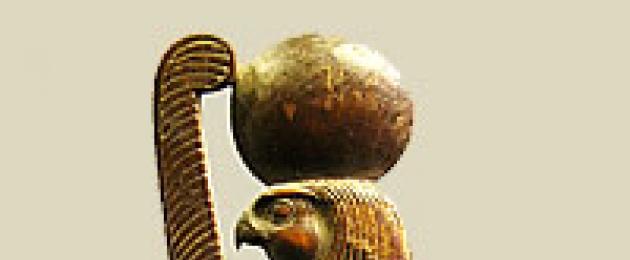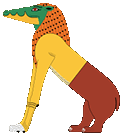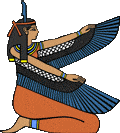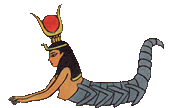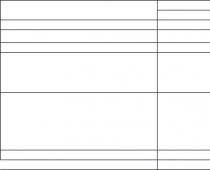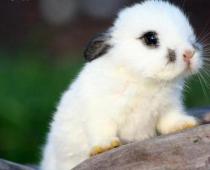The origins of the cult of the sun god Ra
His cult originates from the city, which the Egyptians called Iunu, and the Greeks called Heliopolis (“city of the sun god”). This city was located near modern Cairo and in the era of Ancient Egypt was one of the most important religious and administrative centers of the country.
The origins of the cult of the ancient Egyptian solar deity go back thousands of years, but it is known for sure that already in the Early Dynastic period its influence was very great. It is not for nothing that the name of God was included in the name of one of the pharaohs of the II dynasty, Raneb (“Lord Ra”).
Ra - creator of the world
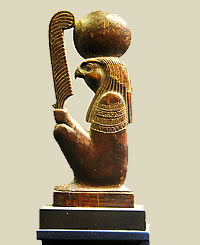 The name Ra (Re) is the Egyptian word for the sun, the most visible of the divine forces that created and maintains the existence of the world.
The name Ra (Re) is the Egyptian word for the sun, the most visible of the divine forces that created and maintains the existence of the world.
According to Heliopolis cosmology, god Ra created himself either from a lotus flower that emerged from the primordial waters, or on the first stone - Benben, which also emerged from water.
He then created Shu (air) and Tefnut (humidity), which in turn gave birth to the sky - the goddess Nut and the earth - the god Geb. From these gods were born Osiris, Set, Isis and Nephthys. From this moment, in fact, the existence of both the Universe and Egypt begins.
According to another myth, which probably arose with the participation of the Memphis priests, he arose from an egg created by Ptah (Ptah), the main god of Memphis.
It was the god Ra who established the cycles of the Egyptian year, the time and the flood of the Nile itself, thus ensuring the very possibility of successful agricultural production in the valley of the great river.
Interestingly, in some myths he is sometimes called a “crybaby.” Egyptian god Ra He also cried because of his tears (in Egyptian “remu”), which fell to the ground, and a man appeared.
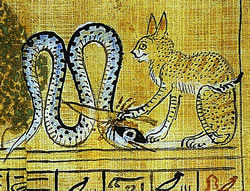 Ra, despite numerous dangers, most often does not play any active role on a night journey (only if he is depicted as a cat, the solar deity himself enters into battle with enemies).
Ra, despite numerous dangers, most often does not play any active role on a night journey (only if he is depicted as a cat, the solar deity himself enters into battle with enemies).
In the guise of Khepri (a man with the head of a ram) or a scarab, the ancient Egyptian sun god is passive and is under the constant protection of his retinue.
The throne with the deity itself is surrounded by the protective deity - the snake Mehen - with the rings of its body.  The actual power of the sun is concentrated in the goddess known as the Eye of Ra, who often guards the prow of the solar barque (often depicted as a snake).
The actual power of the sun is concentrated in the goddess known as the Eye of Ra, who often guards the prow of the solar barque (often depicted as a snake).
Most great blossoming his cult was observed from the beginning of the reign of the V dynasty. The Westcar Papyrus (Egyptian Museum Berlin) says that the sun god in Ancient Egypt was the father of the first pharaohs of the 5th dynasty.
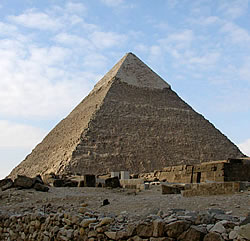 The sun incarnated in Rauser, a priest of the god Ra, to impregnate Rejedet, the mother of the triplets Niuserra, Sahur and Neferirkar, the future pharaohs of this dynasty. When Redjedet felt the approach of childbirth, Ra orders four goddesses - Isis, Nephthys, Heket and Meskhenet - and the god Khnum to help her during childbirth.
The sun incarnated in Rauser, a priest of the god Ra, to impregnate Rejedet, the mother of the triplets Niuserra, Sahur and Neferirkar, the future pharaohs of this dynasty. When Redjedet felt the approach of childbirth, Ra orders four goddesses - Isis, Nephthys, Heket and Meskhenet - and the god Khnum to help her during childbirth.
Of course, this myth-tale contains a lot of historical inaccuracies - the Westcar papyrus was written during the reign of the Hyksos, that is, many centuries after the events described, but the development of the cult of the deity can be traced from other sources.
Solar temples, obelisks, sphinxes and great pyramids were built for him (this is a stone representation of the sun's rays reaching the earth), and in Heliopolis he was also revered under the form of the Benben stone. The hieroglyph meaning “son of Ra” was included in the title of the pharaohs of Egypt.
The name of the Egyptian sun god is now regularly included in the name of kings, for example, Sahura (V Dynasty), Menhererra (XVIII Dynasty), Ramesses ( XIX dynasty). Private individuals - important dignitaries also often had names associated with the sun god, for example, Rekhmirra (“wise like Ra”).
Iconography of Ra
The ancient Egyptian sun god was usually depicted as a man with the head of a falcon or ram, crowned with a solar disk with a uraeus (cobra). When he is depicted with the head of a ram, he has two horizontal frilly horns. Sometimes he is also visualized as a child rising from the primordial lotus flower.
The Egyptians believed that his flesh was made of gold, his bones were silver, and his hair was made of lapis lazuli.
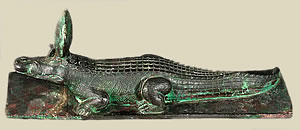 The list of animals in whose form the deity could appear is very wide. These are falcon, ram, Benu bird, cat, lion, bull, mongoose, crocodile, scarab and even a grasshopper. Egyptian sphinxes are also clearly associated with the solar deity.
The list of animals in whose form the deity could appear is very wide. These are falcon, ram, Benu bird, cat, lion, bull, mongoose, crocodile, scarab and even a grasshopper. Egyptian sphinxes are also clearly associated with the solar deity.
During the Old Kingdom, he was the most powerful god, the most transcendent solar deity of the Egyptian pantheon of divine personalities, the “father of all gods,” and had a significant and influential clergy.
In all countries and cities, states and settlements where pagan gods were worshiped, the most celebrated was the cult of the sun. The sun for the pagans was the supreme and most important deity. This is not surprising, because the sun brought warmth and light, symbolized the beginning of a new day and warmed the fields, giving a good harvest. The sun gods were the most revered and respected among the pagans; as a rule, they were considered the supreme gods, the progenitors of all gods, but were called differently in all cultures. In this regard, Ancient Egypt was no different from other ancient peoples.
The sun god among the Egyptians was considered the supreme god; sacrifices were made to him and prayers were offered to him. The sun god was worshiped by everyone, from the common people to the pharaohs. I think that it is no secret to anyone what the sun god was called in Ancient Egypt. Of course, this is Amon Ra. Initially there were two sun gods Amon and Ra, then a merger of these two gods occurred and a single deity appeared - Amon Ra.
Sun gods of Ancient Egypt.
Ancient Egyptian sun god Ra
According to legend, during the day Ra sails on a divine solar boat along the celestial Nile, illuminating the earth, and in the evening he sails along the underground Nile, where he is forced each time to defeat the powerful monster of the serpent Apophis, and at dawn to return again to the sky. The battle between Ra and Apep begins at twelve o'clock at night and ends by dawn. The cult of the god Ra begins to take shape during the reign of the pharaohs of the fourth dynasty and is considered a universal religion. During the reign of the pharaohs of the fifth dynasty, the cult of the sun god became even more entrenched, and these kings were considered the children of Ra. Ra translated means sun, hence the name of the main deity of the Egyptians. Since the pharaohs were considered children of the sun, the syllable “ra” was necessarily included in their names.
Why did the sun god become the main god of the Egyptians? Everything is very logical. It was believed that Ra created the world, was the forefather of all gods and their king, very often Ra was depicted in the guise of a pharaoh, but with the head of a falcon. At first the world was a huge ocean, ruled by the god Nun. Nun created Ra himself. Ra created the god of the wind, the god of the earth and the goddess of the sky. He ordered the wind god Shu to raise the heavens and earth and divide them into two parts. From the words of Ra, people and animals were born, both on earth and in water, and later people came out of the eyes of Ra. Initially, the sun god lived with his creations on earth, taking on the form of a man, and later went to heaven.
The ancient Egyptians attached great importance to the eyes of the god Ra. His eyes were depicted wherever possible and were considered protective amulets. Very often the eyes of Ra were depicted not as eyes, but, for example, in the form of a snake or a warrior. Each eye was assigned its own magical properties; it seemed that the eyes of the god Ra lived a separate, independent life from him.
God Ra was depicted as a man with the head of a falcon. In his hands he held a staff and an Egyptian cross with a loop - ankh. This cross symbolized life, immortality, eternity and wisdom, and was considered a protective sign. The pyramid was considered another symbol of the god Ra; most often this symbol was worn on the body as an amulet. Ra was depicted not only in inanimate symbols. The great sun god was identified with the sacred phoenix bird; it was believed that, like this bird, Ra burns out every evening and rises from the ashes at dawn. God Ra in Ancient Egypt (the pictures allow you to see this) was a revered and respected God.
Ancient Egyptian sun god Amon.
The greatest Ra was not the only solar god of Ancient Egypt. Initially, the sun god Amun was considered a god in only one of the Egyptian cities, namely Thebes. Over time, he acquired the status of a national sun god. Amon appeared to the inhabitants of Egypt as a man wearing a crown with two golden feathers and a thin curled beard. In his hands he held a scepter and an ankh. Like the god Ra, the cult of Amun was also great, especially after he left the city of Thebes. Amon in Thebes was considered the progenitor of all gods, the beginning of the entire universe.
Amon, just like Ra, traveled in his boat across the sky and underground world. When he sailed across the sky, he illuminated the world, when he descended underground, he fought the forces of darkness. The goose and ram, which were symbols of wisdom, were considered the sacred animals of this god. Amon was the most revered god among the pharaohs; later he was credited with the patronage of war and strength.
In the era of the Middle Kingdom, the cult of Amon reaches its apogee, he becomes the supreme state god, the pharaohs are considered his children, so they support his cult with all their might.
Ancient Egyptian sun god Amon Ra.
What is the name of the sun god in Egypt now? Of course, this is a combination of two names of the great gods Amon and Ra. In the sixteenth and seventeenth centuries, during the Middle Kingdom, the cult of the sun god Amon was so strong that Amon became the supreme state god, the ruler of all gods. But another sun god, Ra, was firmly entrenched in the minds and religion of the ancient Egyptians. In this regard, the two most powerful gods merge into one deity - Amon Ra. Amon Ra possessed the traits of both gods, their influence, power and greatness. The Egyptians built the temple of Amun Ra in Thebes, where both pharaohs and ordinary people went.
Ancient people depicted Amon Ra, usually as a man, sometimes as a man with the head of a ram, or entirely as a ram. Like Amon, Amon Ra held in his hands a cross with a loop, which was a symbol of life and immortality.
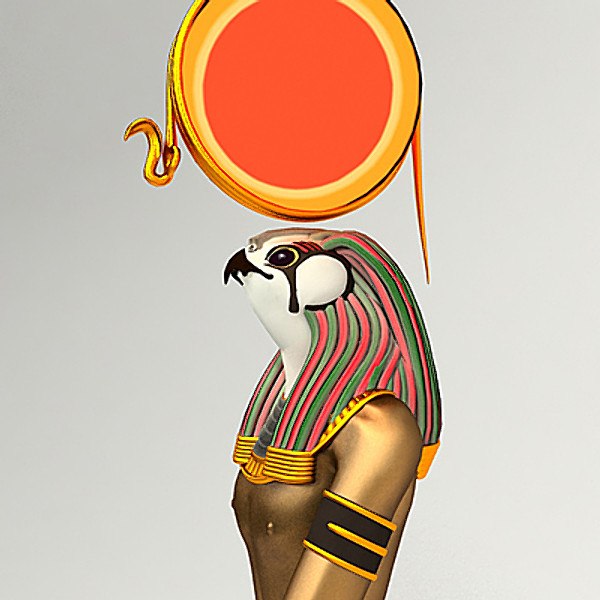
Amon Ra, unlike his halves individually, was a benevolent god, able and willing to extend his divine helping hand to anyone in need. Previously, the afterlife was considered the kingdom of the dead, where eternal cold and darkness reigned. Only the chosen ones could go to heaven in the kingdom of Ra. The new cult of Amun Ra equalized all segments of Egyptian society in religious rights, now heavenly kingdom after death, anyone from a pharaoh and a priest to a person of the lowest social class could end up. The new sun god was presented as a caring and fair father, the creator of all living things and the patron of all things. But despite everything, the god Amon Ra in Ancient Egypt, first and foremost, remained the god of rulers, the god of the pharaohs.
It will be no secret to anyone why the Egyptians revered Amon Ra as their main god. He embodied all the important and strong features of both gods and was officially recognized as the only state sun god.
During the New Kingdom, the veneration of Amon Ra reached its maximum, however, in the era of the Late Kingdom, his exaltation began to slowly fade away. Only in Thebes will he always be revered as before.
This was the sun god Egyptian mythology. The cult of Amon Ra constantly changed its importance, then rose and then fell. Despite the fact that he was considered a democratic god and equalized all people in rights, albeit only in the afterlife, he still remained the officially recognized god of the pharaohs and their patron, their father, their divine incarnation after death. The sun god in Ancient Egypt was and is called Amon Ra, and it is with this name that he will always be associated with people.
Modern Egyptian culture, like any other, stems from mythology. The Egyptians tried to imitate their gods, as they considered them simply a standard of morality and decency. Ancient Egypt attracts, to this day, with its secrets, deep roots and mystery.
General information about the gods of Egypt
Once upon a time, Egypt was called the “gift of the Nile,” because, when the Nile River overflowed, it brought abundant fertile silt, on which crops then grew.
The ancient Egyptians were excellent at building and designing buildings. This is proven by the pyramids, as well as the ruins of ancient temples built in honor of the gods. Their gods did not communicate with people and practically did not interfere in human affairs, but had all the feelings: hatred, love, envy, vindictiveness. The closest thing to the Egyptians was the god of the city in which man lived.
According to ancient beliefs, the gods created water, sky, earth, as well as plants, animals, people, their feelings, etc. It was the deep faith in the gods that prompted this great people to create their architectural masterpieces. The Egyptians wrote down their myths on papyrus scrolls, carved them on the walls of tombs and on the stones of temples. About 200 years ago, the myths were made public - scientist J.F. Champollion was able to decipher the hieroglyphs.
There were approximately 700 Egyptian gods, each had 5 names, each name, in turn, had a connection with one of the elements, as well as with astronomical bodies.
The gods not only created the whole world, but also always supported it, protecting it from troubles and bad weather, although for this it was necessary to worship them. Whether this is actually true we can only guess. But the Egyptians were absolutely confident in their patrons and their vulnerability before the gods.
In Egyptian the word for god is neter. It originally did not mean exactly what we, the Romans or the Greeks, were used to. Neter – venerable, exalted. Accordingly, the Nile River, the sun, the earth and the sky, the heroes of the past, the pharaohs, were all gods.
Creator in Egyptian mythology
Many Egyptian gods are depicted with animal faces, this is due to the fact that the tribes once worshiped the patron beast Totem. After numerous reshuffles, the main gods were nominated in each reign. In ancient Egypt there was no consensus on the creation of the world, only later Ptah began to be considered the creator in mythology (creator god). Initially, his cult developed in the city of Memphis, and then spread throughout Egypt.
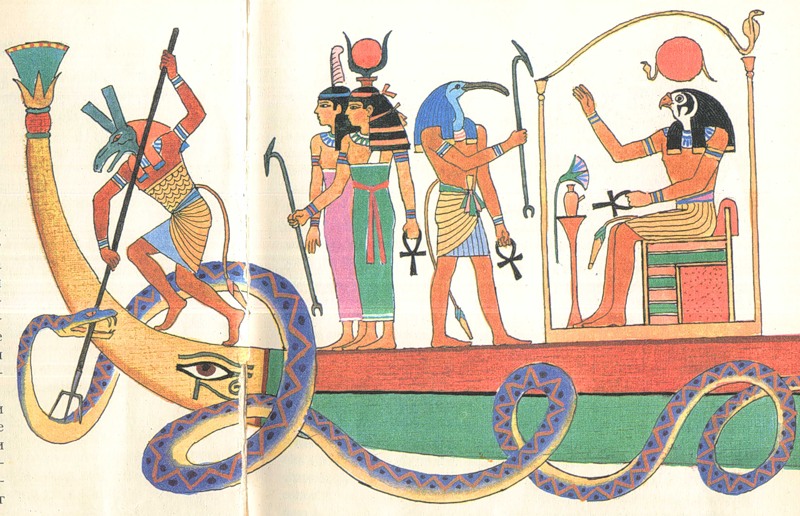
Another name for Ptah is “He who is beyond the southern wall,” meaning by south – eternity. He produced the first 8 gods, who were his hypostases, as well as our world and everything that is in it with tongue and heart. The gods who follow Ptah also include Ra and Osiris. Animals, people, plants, cities, crafts, temples and art: everything exists at the behest of Ptah.
Ptah's wife was the goddess of war Sekhmet, daughter of the god Ra, mother of Nefetrum - the god of vegetation. Sekhmet was revered throughout Egypt and was depicted as a woman with a lion's head. In anger the goddess was terrible. Pestilence, epidemics of diseases fell on people, and her appearance horrified the opponents of the pharaoh whom she guarded. On the other hand, Sekhmet was also a healing goddess; she patronized healers and physicians.
Cult of the god Amun-Ra in Egypt
In Egyptian mythology, as in life, everything is interconnected and each deity is called upon to help people and serve as an example to follow, for example, God Ra, the god of the sun, fought every night with the serpent Apep for the coming of the day. The idea of the sun as a god, or more precisely, as a force that is capable of defeating darkness, gave a person the opportunity to believe in himself. Striving for the ideal, represented by God in the form of a man with a falcon's head, a person had to strive for self-improvement.
Ra also participated in ideas about the change of seasons. For example, if it was a hot, sultry summer, it means Ra was angry with people for something. According to myths, Ra grew old, and people began to plot evil against him, then the sun god gathered a council. The council was headed by the god Nun, who embodied the water element. It was decided to punish the people by sending the goddess Sekhmet to appear as a lioness devouring people. They managed to escape from her only by drinking red barley beer, from which Sekhmet fell asleep and forgot about revenge. After this, Ra left the god Geb as his viceroy on earth, and he himself mounted the back of a heavenly cow and there continues to rule the world.
But in Egypt there was another sun god - Amon. His cult originated in the city of Thebes, and later spread further throughout Egypt. The sky goddess Nut was his wife, who gave birth to a son, the moon god Khonsu. Together they formed the so-called Theban triad. Later, the gods Ra and Amon were united and given a state character. The sun god began to be called Amun-Ra.
This god was a favorite of both the pharaohs and the lower class. Amon-Ra was revered as a wise, omniscient and fair god. He was called the "vizier of the poor", "king of all gods" and "heavenly intercessor". As a result, during the 13th dynasty of the pharaohs, the sun god began to be considered the main one among all gods. Pharaoh Amun-Ra granted victories in battles and battles, and was called his father.
The cult of the solar god Ra was established in Ancient kingdom: 2900-2270 BC And only then, in the Middle Kingdom (2100-1700 BC), it flowed into the cult of Amon and, consequently, into the cult of Amon-Ra.
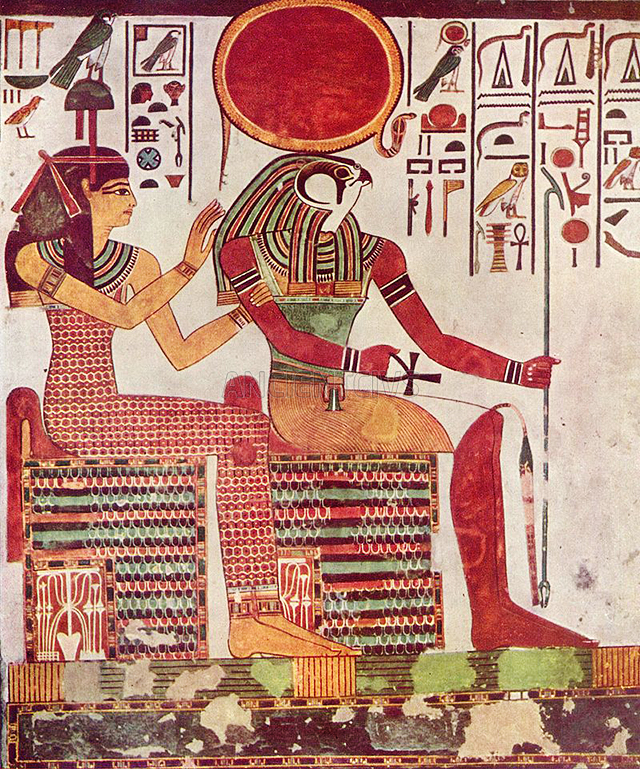
Osiris is the most beloved god of the Egyptians
The ancient Egyptians were very close to the gods, who suffered a lot. Therefore, the god Osiris (ruler of the underworld), his wife Isis, and son Horus are the most revered and beloved characters in Egyptian mythology to this day.
Once Osiris, according to legend, was a king. He was considered the son of the god Geb (earth) and the goddess Nut (sky). His treacherous brother Set, jealous of his fame and power, killed and dismembered Osiris. The faithful wife Isis collected all the parts of her husband, made the first mummy with the help of the god Anubis (patron of the dead, god of embalming) and gave birth to a son, Horus, from Osiris. Set pursued Isis and Horus for a long time, who had to save their lives in the swamps of the Delta. When Horus grew up, he defeated Set. The gods proclaimed Horus the heir of Osiris, and he took his father's throne.
Horus allowed his father to swallow his eye, which Seth had torn out from him, and Osiris came to life. He became the god of the productive forces of nature, as well as the ruler of the underworld and judge in the kingdom of the dead. He taught people winemaking and viticulture, agriculture, ore mining (copper and gold), urban planning, healing, and also established the cult of the gods. He did not want to remain among the people and gave up the throne to his son.
Osiris is depicted as a green man with a vine entwining him. Like all living things flora, he dies every year and is then reborn to a new life.
His wife, the goddess of fertility, wind and water, Isis, is considered a symbol of femininity and fidelity to her husband. Isis helped her husband make Egypt more civilized. She taught Egyptian women to spin and weave, to treat diseases, and introduced the concept of marriage into life. Isis was also the goddess of navigation. In the absence of Osiris (when he was an earthly king), she wisely ruled the country.
The goddess Isis was very popular in Egypt and over time she added features to other goddesses. She was revered as the patroness of women in labor and determined the fate of newborn kings. The cult of Isis influenced mythology ancient Greece, Rome, and also influenced Christianity.
The role of the god Horus (Horus), as noted above, the son of Isis and Osiris, was also important. Since Horus was considered the god of the sun and sky, he was often depicted as a sun with wings. The image of the Egyptian god Horus later also became identified with the god Ra.

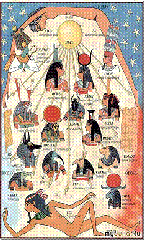
Myths of Ancient Egypt
Egyptian gods Ancient Egypt – names, pantheon
|
|
Amat (Amt, Amamat) |
|
Amon-Ra |
|
|
Anubis |
|
|
Apis |
|
|
Aten |
|
|
Atum |
|
|
Bast |
|
|
Bas |
|
|
Geb |
|
|
Horus (Chorus) |
|
|
Isis |
|
|
|
Maat |
|
Meritseger |
|
|
Meskhent |
|
|
Min |
|
|
Montu |
|
|
Mut |
|
|
Nate |
|
|
Nefertum |
|
|
Nephthys |
|
|
Nekhbet |
|
|
Nun |
|
|
Chickpeas |
|
|
Osiris |
|
|
Ptah |
|
|
Ra |
|
|
Renenet |
|
|
Renpet |
|
|
Sebek |
|
|
|
Selket (Serket) |
|
Serapis |
|
|
Set |
|
|
Sekhmet |
|
|
Seshat |
|
|
Sokar |
|
|
Taurt |
|
|
Tefnut |
|
|
That |
|
|
Upuat |
|
|
Hapi |
|
|
Hathor |
|
|
Khonsou |
|
|
Khnum |
|
|
Shu |
The gods of Egypt were revered by the ancient peoples not just fanatically, as it may seem now.
Gods are certain creatures, which were trees, streams, mountains, the sun, water and everything else that surrounded man.
The gods were sung in song, worshiped in ritual, actually believed in, loved and largely feared.
History describes a lot of moments in the life of the gods, their reign, family relations and warrior. We will try to tell you about the most important and significant gods.
List of all gods of Egypt
Aah or Yah(was the god of the moon).
Aker(god of the Earth).
Aken(the boatman who transported the dead to the dungeon).
Amunet(goddess of invisible forces, wind and air).
Amentet(goddess of the kingdom of the dead).
Amenhotep(god of medicine and wisdom).
Amat(she had the image of a terrible monster and was the goddess of retribution for sins committed).
Ammon(king of the gods and sun god).
Anant(goddess of lust, fertility, war and hunting).
Anedjti.
Anubis(patron of the dead).
Questionnaire(field feeder).
Apis(had the image of a sacred bull and was considered the god of fertility).
Apophis(a huge snake and enemy of Ra).
Atum(creator god).
Ash(god of the desert and patron of all wanderers).
Banebdjedet(god of fertility).
Bapef(god of grief, suffering and pain).
Baht(cow deity).
Babu(baboon god bringing darkness and gloom).
Ben(God eternal life in the form of a heron).
Buhis(a bull god with a black head and white body).
Demon(dwarf god who protects from bad spirits).
Infuriating(the demon's wife).
Venet(rabbit goddess).
Geb(earth god).
Gore(falcon god, guardian of the sky).
Dedun(god of incense).
Jabeth(goddess of the desert in the East).
Imiut(the god in charge of embalming).
Imhotep(patron of doctors and healers).
Iunit(patron of the city of Germont).
Iusat(patron of the city of Heliopolis).
Ihi(God is a musician).
Keket(goddess of darkness).
Kebhut(Egyptian goddess of clean water in Africa).
Cook(god of the night).
Maat(goddess of justice, order and harmony).
Matit(lioness goddess).
Mafdet(goddess of justice).
Mahes(the stern god of warriors and storms).
Menkerot(the goddess who raised those who fell to heaven).
Menket(beer goddess).
Menhit(goddess of protection).
Merimutef(god of the dead, with a ram's head);
Mert(goddess of joy and dancing).
Meskhenet(patron of women in labor).
Mehen(Egyptian god who protected the boat of Ra with the head of a snake).
Mehurt(goddess in the form of a cow who gives birth to rain).
Min(god of productivity).
Montu(a man who has a falcon's head, holds a spear and is the god of war).
Naunet(snake goddess who guards water).
Nebtui(goddess of Latopol).
Nate(creator of people and 7 gods).
Nemti(god of caravan routes and desert).
Nepri(god of grains).
Nefertum(Egyptian god of crop production).
Nekhbet(guarded the pharaohs).
Nehebkau(time keeper).
Nehemetai(anti-theft defender).
Nun(a god who existed before the creation of the world).
Chickpeas(goddess of the sky).
Onuris(god of war and hunting).
Opet(nurse in the form of a hippopotamus).
Panebtavi(had the appearance of a child).
Patek(protector from snakes).
Ptah(created the first gods and the world).
Renenutet(keeper of the harvest).
Reshef(warrior god).
Satis(guardian of the borders of southern Egypt).
Orion(Egyptian god of stars).
Sebek(crocodile god, considered the patron of the Nile).
Sep(patron of the dead in the form of a millipede).
Sarapis(lord of water, air, fire and earth).
Set(personified evil and killed Osiris).
Seshat(goddess of writing).
Sia(god of knowledge).
Sokar(god of mourning).
Tait(goddess of sewing).
Tefnut(goddess of moisture).
That(god of writing and counting).
Tutu(a god with the body of a lion, wings, the head of a man and a snake's tail).
Upes(goddess of fire who burned enemies).
Upuat(god in wolf form).
Ha(god of oases).
Hapi(Egyptian god of all the Nile).
Hathor(goddess who gave birth to the sun).
Hauhet(goddess of everything infinite).
Heket(frog goddess who protected fertile lands).
Khepri(god in the form of a scarab beetle).
Khonsou(god of the moon).
Shai(god of grapes and god who determined life expectancy).
Shed(anti-animal advocate).
Shentit(heavenly cow that resurrected the dead).
Shepes(Egyptian god of law).
Sixth(patron of wine and oil).
Shu(god of air).
Yam(god of the seas).
Let's look at the most significant and famous gods in Egyptian history.
Egyptian god Anubis
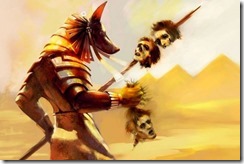
Anubis considered the gods, not man, to be the judge. At the same time, deity was associated with death.
He appeared to the Egyptians as a certain creature lying on the ground, black and terrible.
The Egyptian god Anubis took the souls of people after their death and was the patron saint of the dead. He was depicted as a man with the head of an animal, usually a wolf, or in the form of a jackal.

That was until Anubis moved into the background.
Then Osiris became what Anubis was considered to be, and the slightly modified god was already perceived as an assistant to Osiris, who was entrusted with the responsibility of preparing the body of the deceased, turning it into a mummy with the help of magic.
Egyptian goddess Bastet
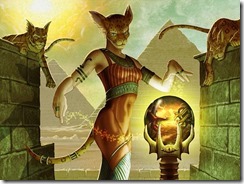
Few gods in Egypt symbolized joy and fun, but Bastet was one of them.
She brought light and hope, since positive traits acted that way on the ancient Egyptians.
Bastet had a son, and she herself appeared as a person with a woman’s body, but the head of a cat.
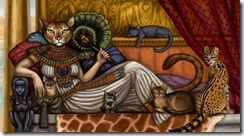
The dawn of the veneration of the goddess occurs in the 10th century before the creation of the world. Since then, the Egyptian cat began to be especially revered by the Egyptians.
Almost every home had this animal, fed it first, loved and respected it. To offend the cat meant to offend Bastet.
In addition, annual festivities were celebrated in honor of the goddess, fun gatherings and many other events were held.
Egyptian goddess Isis
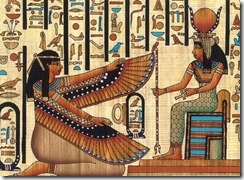
This goddess was important to the ancient Egyptians.
The wife of Osiris was personified as a maiden with a sun disk on her head, and cow horns adorned the disk.
Isis contacts Anubis. It is believed that this goddess found the remains of her husband somewhere during her travels around the planet.
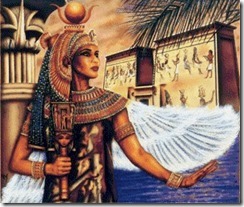
He was killed by his own brother, but it is not mentioned whether the goddess took revenge, but they ignore the fact - Anubis took part in the mummification of Osiris.
The myths of ancient Egypt say that this was the first situation when the first mummy was created. After this, Osiris seemed to come to life and even managed to conceive another son.
Egyptian god Osiris
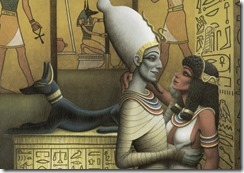
Osiris was the king of the underworld, the god of rebirth. A powerful deity with whom many legends are associated.
The expert version says that Osiris died during the struggle at the hands of Set.
They fought for dominance in the world - Osiris taught people healing skills, told them how to build houses, cities, and how to run a household. this was not part of the plans of Set, the god of the desert, who wanted to rule everything on his own, so that there would be only sand and voids around.
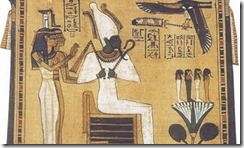
Gods in Ancient Egypt are associated with various events.
It is believed that Osiris was divided into 14 body parts, which were scattered throughout Africa.
Osiris's wife, Isis, put all his parts together and was even able to conceive a child from him after death, whom she safely gave birth to and raised.
Sun God Ra
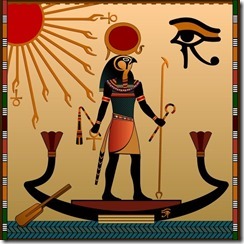
Ra was incarnated as a cat or falcon large sizes. The Egyptians also depicted him as a man with a large falcon's head.
It was believed that Ra was the god of the daytime sun.
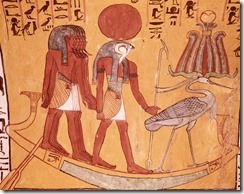
Evening and morning are not his time. Ra was connected with the afterlife, warmed and illuminated the path of the dead, who rushed upward to contact the deities. The sun god Ra was distinguished by the fact that he had his own guardian - the fire-breathing snake Uto.
Egyptian god Set
This is the god of chaos, disorder and everything bad that happens around, which leads to chaos.
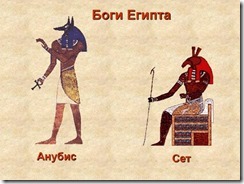
It was depicted as a creature that has the body of a man, and the head of some mythical entity. It's hard to say whose head it was - perhaps an anteater.
Seth has been portrayed in various ways. Sometimes he took on the appearance of a donkey and other animals. The main difference is the forked tail, which distinguished an ordinary creature from a deity.
It is believed that Set was the brother of Anubis.
Nebethat is a goddess who is both the sister and wife of Set. Seth's appearance was compared to a beautiful male body, with sexuality and masculinity, but at the same time extreme cruelty.
According to legend, the Egyptian god Set killed Osiris, his brother, who tore out his eye and cut it into 14 pieces, and then scattered it across the deserts.

Set was considered the god of the deserts; he was patronized by travelers and nomadic Africans.
Seth had many New Kingdom mistresses and wives.
African culture was largely based on mythology, beliefs in gods, and patronage of them.
Thanks to the Egyptian gods, according to Africans, it was possible to become healthy, bring a curse on the enemy, protect yourself and loved ones, and gain fertility.
Magic and witchcraft in some way today are based on previously existing activities involving the gods.
- In contact with 0
- Google+ 0
- OK 0
- Facebook 0

